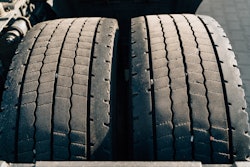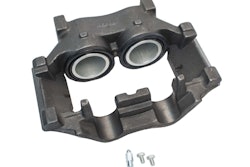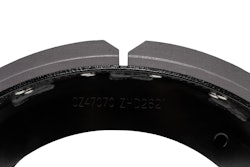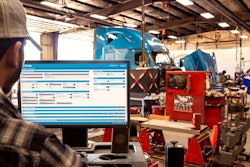
Hurricane Ian flooded plenty of vehicles and rekindled memories of Hurricane Katrina for Dale Franklin, assistant vice president of strategic operations at Amerit Fleet Solutions, who recalled how some vehicles can end up too far gone to be put back on the road.
That was pretty obvious for trucks that had been sitting in water for two weeks with flooded cabs following the destructive Category 3 storm, which made landfall near New Orleans on August 29, 2005.
“There wasn't much left to do with those,” Franklin said. “They sat there so long, that water got toxic and then we had to tell our guys to be very careful whenever they opened the door in one of those. It was godawful whenever they got those vehicles towed in.”
[Related: Tips for freeing up a frozen brake caliper]
Other vehicles can be saved from floodwaters but knowing the extent of water intrusion and the type of water (salt of fresh), will dictate the steps taken to get that truck back into service.
First up is knowing which trucks in your fleet were actually exposed to flooded areas. It may not be so obvious at first. For instance, drivers may forge ahead through a flooded street with roughly axle-high water without thinking of potential consequences to vulnerable brake systems and wheel ends. That’s where GPS can come in handy.
“We monitor our trucks by computer and GPS so we know where they’re at and what they’re doing,” said Jeff Fazan, lease and rental service manager at Tom Nehl Truck Leasing in Jacksonville, Florida.
“If we see trucks that are in an area that is a flooded area, we try to notify our customer and get them in on our PM cycles so we can check them out and make sure that the wheel ends are washed out and cleaned,” Fazan continued.
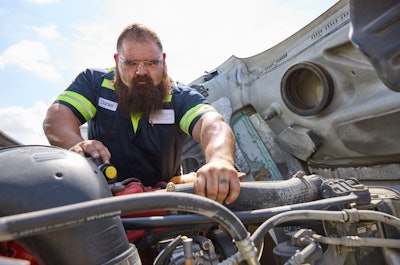 It's always best to thoroughly inspect and address any flooding issues. "Running any system with fresh or saltwater contamination can cause catastrophic failure," said Tim MacQueen, area vice president of vehicle operations at Cox Automotive Mobility Fleet Services. "All components need to be checked and serviced accordingly before customers just go and start the vehicles."Cox Automotive Mobility Fleet Services
It's always best to thoroughly inspect and address any flooding issues. "Running any system with fresh or saltwater contamination can cause catastrophic failure," said Tim MacQueen, area vice president of vehicle operations at Cox Automotive Mobility Fleet Services. "All components need to be checked and serviced accordingly before customers just go and start the vehicles."Cox Automotive Mobility Fleet Services
“I have had trailers that were submerged up to their axles and we had to take all the hubcaps off the trailers, drain all the fluids, clean all the bearings, put new seals in and redo the fluids in the axles,” said Angelo Cinquegrana, assistant vice president of field operations at Amerit Fleet Solutions.
Storms aren’t the only concern for flooding. Some loading docks, Nehl said, are prone to flooding from groundwater “where there are not proper pump systems.” Drivers may park their trucks at flooded docks without giving it much thought.
“We have problems where trucks are dropped into those situations to be unloaded, or a straight truck is backed into a situation for hours while it is unloaded, and the wheel ends are sitting underwater and that is where the integrity of the vent system and the hub caps come into play because we have seen where we have had water intrusions into hub caps on trailers causing a milky oil situation,” Nehl added. “So we try to make the drivers aware that when they are in that situation to let somebody know so we can inspect the wheel ends on the truck when they get back into the shop.”
‘Saltwater is very corrosive’
Saltwater from coastal storm surges can be particularly hard on vehicles since it’s more corrosive than freshwater.“Saltwater is much more corrosive than freshwater as anyone who lives in a coastal area can attest to,” said David Kegley, Ryder System director for maintenance training and development. “Metal and electrical connections begin to degrade almost immediately after saltwater exposure.”
Kegley said it’s best to swap out submerged parts and the parts that don't get swapped out need to be looked at closely.
“Electrical wiring subjected to total submersion, especially in brackish or salt water, requires complete replacement,” Kegley explained. “This includes lighting, anti-lock braking systems, and add-on devices. Replace air brake system air drier or desiccant filter. Submerged air valves, brake chambers, linings and hardware kits must be replaced. Electronic control modules that have been submerged will need to be replaced. Perform vehicle lubrication, ensuring greasing operations purge all water from lube points. Verify proper operation of all air brake and ride height controls.”
Brake components can be more at risk since several components are exposed to the elements.
“Saltwater is very corrosive to the rotors, drums and mechanical components like slack adjusters and S-Cams,” said Tim MacQueen, area vice president of vehicle operations at Cox Automotive Mobility Fleet Services. “You’ll need to check for additional wear and seal integrity.”
Matt Copot, vice president of maintenance at Transervice, pointed out how ABS systems, sensors, ATIS, TPMS, rotors, calipers, drums will all begin to corrode immediately in the presence of salt water.
“While neither is a good thing for a truck braking system, saltwater will corrode the metals and wiring for a longer period of time and more quickly than freshwater,” Copot said.
If you’ve not sure if a vehicle has been exposed to salt water, it’s always best to err on the side of caution and treat it as if it was. The sooner a truck is treated, the better.
“It’s imperative that the vehicle be cleaned of all traces of salt,” Copot continued. “A good pressure washer and detergent will go a long way in slowing down corrosion. Follow your PM process and ensure the vehicles are being checked for corrosion during every maintenance service. Remove and replace all lubricants that were submerged to include, hubs, diffs, transmission, engine oil, etc.”
When it comes to taking on components submerged in saltwater, the safest bet according to Randy Salvatora, Bendix’ vehicles systems engineering manager, is to remove and replace those affected parts.
“Saltwater corrosion is also a threat to wheel-ends, since it increases the likelihood of rust jacking and accelerates corrosion of critical surfaces,” Salvatora explained. “So, we recommend complete replacement of the foundation brakes to prevent a potential future failure. And if it’s not clear whether the water was fresh or salt, play it safe and follow the saltwater guidelines.”
Joe Kay, director of engineering at Meritor, pointed out that in addition to salt, floodwater can come with other challenges.
"The water is likely to contain salt from the ocean or debris, such as mud or sand," Kay said. "The deeper a vehicle was submerged means the inspection process needs to be greater due to the water line. Foundation brakes are lowest, then valves and air lines then the compressor air dryers and controls are mounted highest."
Playing it safe
Servicing a truck for either salt or freshwater flooding is no guarantee against further problems down the road.Electronic components and wire harnesses are particularly concerning since connectivity issues are often out of sight.
“What we are really watching now is all the electronics on the truck. That is a big thing, especially with sensors and connectors,” Nehl said. “Any type of water intrusion, either freshwater or salt water, in some of these connections on the tractors and trailers, we have been seeing issues there.”
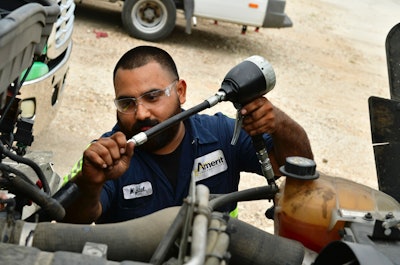 Not all flooded vehicles can be recovered.
Not all flooded vehicles can be recovered.
"If it got into the motor and into the cab, they're throwaways at that point," said for Dale Franklin, assistant vice president of strategic operations at Amerit Fleet Solutions.Amerit
“We recommend retesting and diagnostic checks of the electronic systems after the initial post-flood testing,” Salvatora said. “Additionally, make sure you’re following other vehicle and system manufacturers’ guidelines. Flooding can have bumper-to-bumper effects, and you can’t be too careful.”
Though the truck may appear ready to crank up and move, do not attempt to start it if water has entered the air compressor or dryer through the air system intake. If you’re not sure, it’s best to have the truck inspected before cranking it up. That not only helps protect the truck, it can also make for safer roads.
“Every customer affected by any storm surge, or any flooding, should have their vehicles inspected for all components before putting the unit back on the road with the motoring public,” MacQueen said. “This small inspection by trained professionals could save their company liability on the road or liability with catastrophic failure.”
Kay advised to check drain holes on the non-pressure side of brake chambers.
"Make sure they are not clogged," Kay said. "Removing air lines and assuring water has not entered into the apply system or the parking release system is important. If water gets in, there can be long term corrosion effects. One of the bigger concerns would be 'hydraulically' locking the brake chamber so the force won’t be applied to the brake."
Once a flooded vehicle is serviced and deemed safe to hit the road, it’s best to step up PMs to ensure vehicle integrity.
“I would do a 90-day check on the unit and look at all those things to make sure we don't have water intrusion continuing with any of those components,” Cinquegrana said. “Do that for the next year just to keep an eye on those things and make sure that water is not affecting it.”


